Study on Stratified Settlement and Weak Reflectivity Fiber Grating Monitoring of Shield Tunnel Crossing Composite Strata
Abstract
1. Introduction
2. Engineering Background
2.1. Project Overview
2.2. Field Monitoring Layout
2.3. Establishment of Numerical Simulation Model
- (1)
- The initial ground stress equilibrium was established, the initial ground stress field was obtained, and the initial displacement was returned to zero.
- (2)
- ABAQUS birth and death element method was used to kill the 3 m excavation soil element, and the temperature field was used to change the soil elastic modulus and Poisson’s ratio, which was used to simulate the stress release in the soil excavation process.
- (3)
- The ABAQUS life and death element method activate the 3 m lining segment element in contact with the soil. Shield excavation of 3 m soil, assembling 3 m lining segments as a complete analysis step, the whole process of a total of 20 cycles to simulate the whole process of shield tunneling.
3. Results and Analysis
3.1. Evolution Law of Surface Subsidence
3.1.1. Field Monitoring Results
3.1.2. Numerical Simulation Results
3.2. Evolution Law of Stratum Settlement at Different Depths with Shield Tunneling
3.2.1. Field Monitoring Results
3.2.2. Numerical Simulation Results
4. Discussion
- (1)
- For the existing buildings (structures) located in the main disturbance layer and the main disturbance area, the above research shows that the soil unloading in this area is obvious in the shield approaching stage. R. J. Finno and G. W. Clough [57] through the field measurement and finite element simulation of the shield construction of the San Francisco tunnel in the United States, it is found that properly increasing the cutterhead pressure to make the ground in front of the excavation face slightly uplift in advance can reduce the total ground loss during the construction period, and then better control the settlement during the construction process. This experience is confirmed by most projects. Therefore, the support pressure of excavation face should be appropriately increased to balance the overload effect and reduce the settlement caused by unloading of excavation face before crossing; During the shield crossing stage, the shield tunneling speed should be kept stable to reduce the adverse effects on the surrounding strata and existing buildings. Properly increasing the shield tunneling speed can reduce the amount and development speed of ground settlement. The shield advance speed of this project is controlled at 25~30 mm / min; The shield tail stripping stage is the main stage of disturbance. Synchronous grouting should be used to fill the excavation gap, and secondary grouting should be used to fill the gap behind the segment. Colleagues should avoid abnormal shutdown of shield at this stage, and strive to minimize the time of stripping stage.
- (2)
- For the existing buildings (structures) located in the main disturbance layer and the secondary disturbance area, the shield crossing stage, to ensure that the shield uniform construction, shield attitude change should not be too large, over-frequency. In this project, the advance of the segment is checked every 4 rings, and the change of the folding angle between the tunnel axis and the shield axis cannot exceed 0.4 %. To avoid the excessive angle between the shield and the segment, the plane position of the shield machine is controlled within the design axis ±50 mm, and the elevation is controlled within −50 mm. At the same time, in order to reduce land subsidence, in the process of crossing, it is strictly prohibited to correct a large number of deviations, only less or no correction.
- (3)
- For the existing buildings (structures) located in the secondary disturbance layer and the main disturbance area, the tunneling speed, tunneling attitude, cutterhead torque and rotational speed should be paid attention to in the approaching stage of shield tunneling. Under the premise of ensuring the smooth tunneling of the excavation face, the cutterhead speed should be increased and the cutterhead torque should be reduced, which is conducive to the control of stratum settlement; During the shield crossing stage, the long time shelving of the shield machine should be avoided and the crossing interval should be minimized on the basis of the above basic control measures. In the stage of shield tail detachment, synchronous grouting is needed to fill the gap of shield tail, and then whether secondary grouting is needed is determined according to the real-time monitoring data of stratum settlement.
- (4)
- For the existing buildings (structures) located in the secondary disturbance layer and secondary disturbance area, the tunneling speed and attitude should be paid attention to in the approaching and crossing stage of shield tunneling; In the stage of shield tail detachment, synchronous grouting was used to fill the shield tail gap, and then according to the real-time monitoring data of stratum settlement, whether to use secondary grouting to fill the gap behind the segment was determined.
5. Conclusions
- (1)
- The weak reflectivity fiber grating sensing technology can better perceive the evolution law and distribution characteristics of vertical and horizontal settlement of composite strata caused by shield tunneling, which is in good agreement with the numerical simulation results, and has the advantages of automation and high precision, it can be used as a supplement and alternative method for traditional measurement methods.
- (2)
- The vertical and horizontal partition (layer) system of layered settlement of composite strata with the temporal and spatial evolution of shield tunneling is constructed. The temporal and spatial evolution law of ground settlement at different depths with shield tunneling can be divided into three stages in the longitudinal direction, namely, the shield approaching stage (−5D~0), the shield crossing stage (0~1D) and the shield tail detachment stage (1D~5D), and the 3D range after the shield crossing and the shield tail detachment is the longitudinal main disturbance area of layered settlement. Horizontally, the overlying composite strata are divided into main disturbance layer and secondary disturbance layer according to the influence of shield tunneling disturbance. Among them, the range of 0.5D stratum above the tunnel is the main disturbance layer.
- (3)
- According to the influence zone of the building (structure) and the different stages of shield construction, corresponding effective control measures can be taken to achieve accurate control of stratum displacement and safe and efficient tunneling of shield.
Author Contributions
Funding
Institutional Review Board Statement
Informed Consent Statement
Data Availability Statement
Acknowledgments
Conflicts of Interest
References
- Xie, X.; Yang, Y.; Ji, M. Analysis of ground surface settlement induced by the construction of a large-diameter shield-driven tunnel in Shanghai, China. Tunn. Undergr. Space Technol. 2016, 51, 120–132. [Google Scholar] [CrossRef]
- Chen, S.L.; Gui, M.W.; Yang, M.C. Applicability of the principle of superposition in estimating ground surface settlement of twin-and quadruple-tube tunnels. Tunn. Undergr. Space Technol. 2012, 28, 135–149. [Google Scholar] [CrossRef]
- Huang, X.; Huang, H.; Zhang, J. Flattening of jointed shield-driven tunnel induced by longitudinal differential settlements. Tunn. Undergr. Space Technol. 2012, 31, 20–32. [Google Scholar] [CrossRef]
- Ocak, I. Interaction of longitudinal surface settlements for twin tunnels in shallow and soft soils: The case of Istanbul Metro. Environ. Earth Sci. 2013, 69, 1673–1683. [Google Scholar] [CrossRef]
- Liang, J.; Tang, X.; Wang, T.; Lin, W.; Yan, J.; Fu, C. Analysis for Ground Deformation Induced by Undercrossed Shield Tunnels at a Small Proximity Based on Equivalent Layer Method. Sustainability 2022, 14, 9972. [Google Scholar] [CrossRef]
- Zhu, Y.; Zhou, J.; Zhang, B.; Wang, H.; Huang, M. Statistical analysis of major tunnel construction accidents in China from 2010 to 2020. Tunn. Undergr. Space Technol. 2022, 124, 104460. [Google Scholar] [CrossRef]
- Liang, Y.; Chen, X.; Yang, J.; Zhang, J.; Huang, L. Analysis of ground collapse caused by shield tunnelling and the evaluation of the reinforcement effect on a sand stratum. Eng. Fail. Anal. 2020, 115, 104616. [Google Scholar] [CrossRef]
- Seol, H.; Won, D.; Jang, J.; Kim, K.Y.; Yun, T.S. Ground Collapse in EPB shield TBM site: A case study of railway tunnels in the deltaic region near Nak-Dong River in Korea. Tunn. Undergr. Space Technol. 2022, 120, 104274. [Google Scholar] [CrossRef]
- Liu, C.; Zhang, Z.; Regueiro, R.A. Pile and pile group response to tunnelling using a large diameter slurry shield–Case study in Shanghai. Comput. Geotech. 2014, 59, 21–43. [Google Scholar] [CrossRef]
- Lin, C.; Huang, M.; Nadim, F.; Liu, Z. Embankment responses to shield tunnelling considering soil-structure interaction: Case studies in Hangzhou soft ground. Tunn. Undergr. Space Technol. 2020, 96, 103230. [Google Scholar] [CrossRef]
- Ding, Z.; Zhang, M.B.; Zhang, X.; Wei, X.J. Theoretical analysis on the deformation of existing tunnel caused by under-crossing of large-diameter slurry shield considering construction factors. Tunn. Undergr. Space Technol. 2023, 133, 104913. [Google Scholar] [CrossRef]
- Dalong, J.; Xiang, S.; Dajun, Y. Theoretical analysis of three-dimensional ground displacements induced by shield tunneling. Appl. Math. Model. 2020, 79, 85–105. [Google Scholar] [CrossRef]
- Hu, B.; Wang, C. Ground surface settlement analysis of shield tunneling under spatial variability of multiple geotechnical parameters. Heliyon 2019, 5, e02495. [Google Scholar] [CrossRef]
- Wang, J.; Feng, K.; Wang, Y.; Lin, G.; He, C. Soil disturbance induced by EPB shield tunnelling in multilayered ground with soft sand lying on hard rock: A model test and DEM study. Tunn. Undergr. Space Technol. 2022, 130, 104738. [Google Scholar] [CrossRef]
- Xu, Q.; Zhu, H.; Ding, W.; Ge, X. Laboratory model tests and field investigations of EPB shield machine tunnelling in soft ground in Shanghai. Tunn. Undergr. Space Technol. 2011, 26, 1–14. [Google Scholar] [CrossRef]
- Berthoz, N.; Branque, D.; Subrin, D.; Wong, H.; Humbert, E. Face failure in homogeneous and stratified soft ground: Theoretical and experimental approaches on 1g EPBS reduced scale model. Tunn. Undergr. Space Technol. 2012, 30, 25–37. [Google Scholar] [CrossRef]
- Lin, Q.; Lu, D.; Lei, C.; Tian, Y.; Gong, Q.; Du, X. Model test study on the stability of cobble strata during shield under-crossing. Tunn. Undergr. Space Technol. 2021, 110, 103807. [Google Scholar] [CrossRef]
- Fang, Y.; Chen, Z.; Tao, L.; Cui, J.; Yan, Q. Model tests on longitudinal surface settlement caused by shield tunnelling in sandy soil. Sustain. Cities Soc. 2019, 47, 101504. [Google Scholar] [CrossRef]
- Jiang, H.; Cheng, J.; Zhang, J.; Zhang, J.; Su, Y.; Zheng, Y. Principle and application of in-situ monitoring system for ground displacement induced by shield tunnelling. Tunn. Undergr. Space Technol. 2021, 112, 103905. [Google Scholar] [CrossRef]
- Liu, Y.; Liao, S.; Chen, L.; Liu, M. Structural responses of DOT tunnel induced by shield under-crossing in close proximity in soft ground. Part I: Field measurement. Tunn. Undergr. Space Technol. 2022, 128, 104623. [Google Scholar] [CrossRef]
- Mu, B.; Xie, X.; Li, X.; Li, J.; Shao, C.; Zhao, J. Monitoring, modelling and prediction of segmental lining deformation and ground settlement of an EPB tunnel in different soils. Tunn. Undergr. Space Technol. 2021, 113, 103870. [Google Scholar] [CrossRef]
- Fang, K.; Yang, Z.; Jiang, Y.; Sun, Z.; Wang, Z. Surface subsidence characteristics of fully overlapping tunnels constructed using tunnel boring machine in a clay stratum. Comput. Geotech. 2020, 125, 103679. [Google Scholar] [CrossRef]
- Deng, H.; Fu, H.; Shi, Y.; Huang, Z.; Huang, Q. Analysis of Asymmetrical Deformation of Surface and Oblique Pipeline Caused by Shield Tunneling along Curved Section. Symmetry 2021, 13, 2396. [Google Scholar] [CrossRef]
- Ren, D.J.; Xu, Y.S.; Shen, J.S.; Zhou, A.; Arulrajah, A. Prediction of ground deformation during pipe-jacking considering multiple factors. Appl. Sci. 2018, 8, 1051. [Google Scholar] [CrossRef]
- Yang, W.; Zheng, J.; Zhang, R.; Liu, H. An analytical method for predicting equivalent gap parameter induced by 3D deformation at the face of shield tunnel in soft clay. Tunn. Undergr. Space Technol. 2022, 130, 104736. [Google Scholar] [CrossRef]
- Liu, S.; Wang, Y.; Zhou, H.; Sun, C.; Lin, D. Model test on approaching the construction of multi-line overlapping shield tunnels for up-and down-crossing. Processes 2022, 10, 500. [Google Scholar] [CrossRef]
- Yang, J.; Liu, C.; Chen, Q.; Xie, X. Performance of overlapped shield tunneling through an integrated physical model tests, numerical simulations and real-time field monitoring. Undergr. Space. 2017, 2, 45–59. [Google Scholar] [CrossRef]
- Lin, Q.; Lu, D.; Lei, C.; Tian, Y.; Kong, F.; Du, X. Mechanical response of existing tunnels for shield under-crossing in cobble strata based on the model test. Tunn. Undergr. Space Technol. 2022, 125, 104505. [Google Scholar] [CrossRef]
- Xu, Y.; Sun, J.; Fu, D.; Dong, P. Soil disturbance of Shanghai silty clay during EPB tunnelling. Tunn. Undergr. Space Technol. 2003, 18, 537–545. [Google Scholar] [CrossRef]
- Lin, C.G.; Zhang, Z.M.; Wu, S.M.; Yu, F. Key techniques and important issues for slurry shield under-passing embankments: A case study of Hangzhou Qiantang River Tunnel. Tunn. Undergr. Space Technol. 2013, 38, 306–325. [Google Scholar] [CrossRef]
- Zhou, Z.; Ding, H.; Miao, L.; Gong, C. Predictive model for the surface settlement caused by the excavation of twin tunnels. Tunn. Undergr. Space Technol. 2021, 114, 104014. [Google Scholar] [CrossRef]
- Deng, H.S.; Fu, H.L.; Yue, S.; Huang, Z.; Zhao, Y.Y. Ground loss model for analyzing shield tunneling-induced surface settlement along curve sections. Tunn. Undergr. Space Technol. 2022, 119, 104250. [Google Scholar] [CrossRef]
- Shen, S.L.; Wu, H.N.; Cui, Y.J.; Yin, Z.Y. Long-term settlement behaviour of metro tunnels in the soft deposits of Shanghai. Tunn. Undergr. Space Technol. 2014, 40, 309–323. [Google Scholar] [CrossRef]
- Song, H.; Pei, H.; Zhu, H. Monitoring of tunnel excavation based on the fiber Bragg grating sensing technology. Measurement 2021, 169, 108334. [Google Scholar] [CrossRef]
- Maheshwari, M.; Yang, Y.; Upadrashta, D.; Huang, E.S.; Goh, K.H. Fiber Bragg grating (FBG) based magnetic extensometer for ground settlement monitoring. Sens. Actuat. A-Phys. 2019, 296, 132–144. [Google Scholar] [CrossRef]
- Wang, H.P.; Dai, J.G.; Wang, X.Z. Improved temperature compensation of fiber Bragg grating-based sensors applied to structures under different loading conditions. Opt. Fiber Technol. 2021, 63, 102506. [Google Scholar] [CrossRef]
- Pan, J.; Hou, W.; Wang, L.; Lv, H. High-precision continuous deformation monitoring method based on ultra-weak FBG array. Opt. Fiber Technol. 2022, 73, 103068. [Google Scholar] [CrossRef]
- Gong, H.; Kizil, M.S.; Chen, Z.; Amanzadeh, M.; Yang, B.; Aminossadati, S.M. Advances in fibre optic based geotechnical monitoring systems for underground excavations. Int. J. Min. Sci. Technol. 2019, 29, 229–238. [Google Scholar] [CrossRef]
- Zhou, Z.; Liu, W.; Huang, Y.; Wang, H.; Jianping, H.; Huang, M.; Jinping, O. Optical fiber Bragg grating sensor assembly for 3D strain monitoring and its case study in highway pavement. Mech. Syst. Signal Pract. 2012, 28, 36–49. [Google Scholar] [CrossRef]
- Lai, H.; Zheng, H.; Chen, R.; Kang, Z.; Liu, Y. Settlement behaviors of existing tunnel caused by obliquely under-crossing shield tunneling in close proximity with small intersection angle. Tunn. Undergr. Space Technol. 2020, 97, 103258. [Google Scholar] [CrossRef]
- Hu, X.; He, C.; Peng, Z.; Yang, W. Analysis of ground settlement induced by Earth pressure balance shield tunneling in sandy soils with different water contents. Sustain. Cities Soc. 2019, 45, 296–306. [Google Scholar] [CrossRef]
- Yin, M.; Jiang, H.; Jiang, Y.; Sun, Z.; Wu, Q. Effect of the excavation clearance of an under-crossing shield tunnel on existing shield tunnels. Tunn. Undergr. Space Technol. 2018, 78, 245–258. [Google Scholar] [CrossRef]
- Fang, Y.S.; Wu, C.T.; Chen, S.F.; Liu, C. An estimation of subsurface settlement due to shield tunneling. Tunn. Undergr. Space Technol. 2014, 44, 121–129. [Google Scholar] [CrossRef]
- Jin, H.; Yuan, D.; Zhou, S.; Zhao, D. Short-Term and Long-Term Displacement of Surface and Shield Tunnel in Soft Soil: Field Observations and Numerical Modeling. Appl. Sci. 2022, 12, 3564. [Google Scholar] [CrossRef]
- Wang, X.T.; von Schmettow, T.; Chen, X.S.; Xia, C.Q. Prediction of ground settlements induced by twin shield tunnelling in rock and soil–A case study. Undergr. Space 2022, 7, 623–635. [Google Scholar] [CrossRef]
- Sirivachiraporn, A.; Phienwej, N. Ground movements in EPB shield tunneling of Bangkok subway project and impacts on adjacent buildings. Tunn. Undergr. Space Technol. 2012, 30, 10–24. [Google Scholar] [CrossRef]
- Nematollahi, M.; Dias, D. Three-dimensional numerical simulation of pile-twin tunnels interaction–Case of the Shiraz subway line. Tunn. Undergr. Space Technol. 2019, 86, 75–88. [Google Scholar] [CrossRef]
- Zheng, G.; Fan, Q.; Zhang, T.; Zhang, Q. Numerical study of the Soil-Tunnel and Tunnel-Tunnel interactions of EPBM overlapping tunnels constructed in soft ground. Tunn. Undergr. Space Technol. 2022, 124, 104490. [Google Scholar] [CrossRef]
- Gou, Y.; Huang, Q.; Kang, X.; Wang, L.; Yang, X.; Teng, H. Experimental study on the mechanical response of metro shield tunnels obliquely crossing ground fissures. Tunn. Undergr. Space Technol. 2023, 132, 104849. [Google Scholar] [CrossRef]
- Lou, P.; Li, Y.; Tang, X.; Lu, S.; Xiao, H.; Zhang, Z. Influence of double-line large-slope shield tunneling on settlement of ground surface and mechanical properties of surrounding rock and segment. Alex. Eng. J. 2023, 63, 645–659. [Google Scholar] [CrossRef]
- Mei, Y.; Zhou, D.; Shi, W.; Zhang, Y.; Zhang, Y. Laws and Numerical Analysis of Surface Deformation Caused by Excavation of Large Diameter Slurry Shield in Upper-Soft and Lower-Hard Composite Stratum. Buildings 2022, 12, 1470. [Google Scholar] [CrossRef]
- Wang, F.; Shao, J.; Li, W.; Wang, L.; Wang, Y.; Liu, H. Numerical simulation study on lining damage of shield tunnel under train load. Sustainability 2022, 14, 14018. [Google Scholar] [CrossRef]
- Ziegler, M.; Lavasan, A.A.; Loew, S. Stress evolution around a TBM tunnel in swelling clay shale over four years after excavation. Tunn. Undergr. Space Technol. 2022, 128, 104649. [Google Scholar] [CrossRef]
- Huang, L.; Si, X.; Li, X.; Gong, F.; Luo, Y. Influence of maximum principal stress direction on the failure process and characteristics of D-shaped tunnels. Int. J. Min. Sci. Technol. 2022, 32, 1125–1143. [Google Scholar] [CrossRef]
- Tian, Y.; Qaytmas, A.M.; Lu, D.; Du, X. Stress path of the surrounding soil during tunnel excavation: An experimental study. Transp. Geotech. 2023, 38, 100917. [Google Scholar] [CrossRef]
- Lin, X.T.; Chen, R.P.; Wu, H.N.; Cheng, H.Z. Three-dimensional stress-transfer mechanism and soil arching evolution induced by shield tunneling in sandy ground. Tunn. Undergr. Space Technol. 2019, 93, 103104. [Google Scholar] [CrossRef]
- Finno, R.J.; Clough, G.W. Evaluation of soil response to EPB shield tunneling. J. Geotech. Eng. 1985, 111, 155–173. [Google Scholar] [CrossRef]
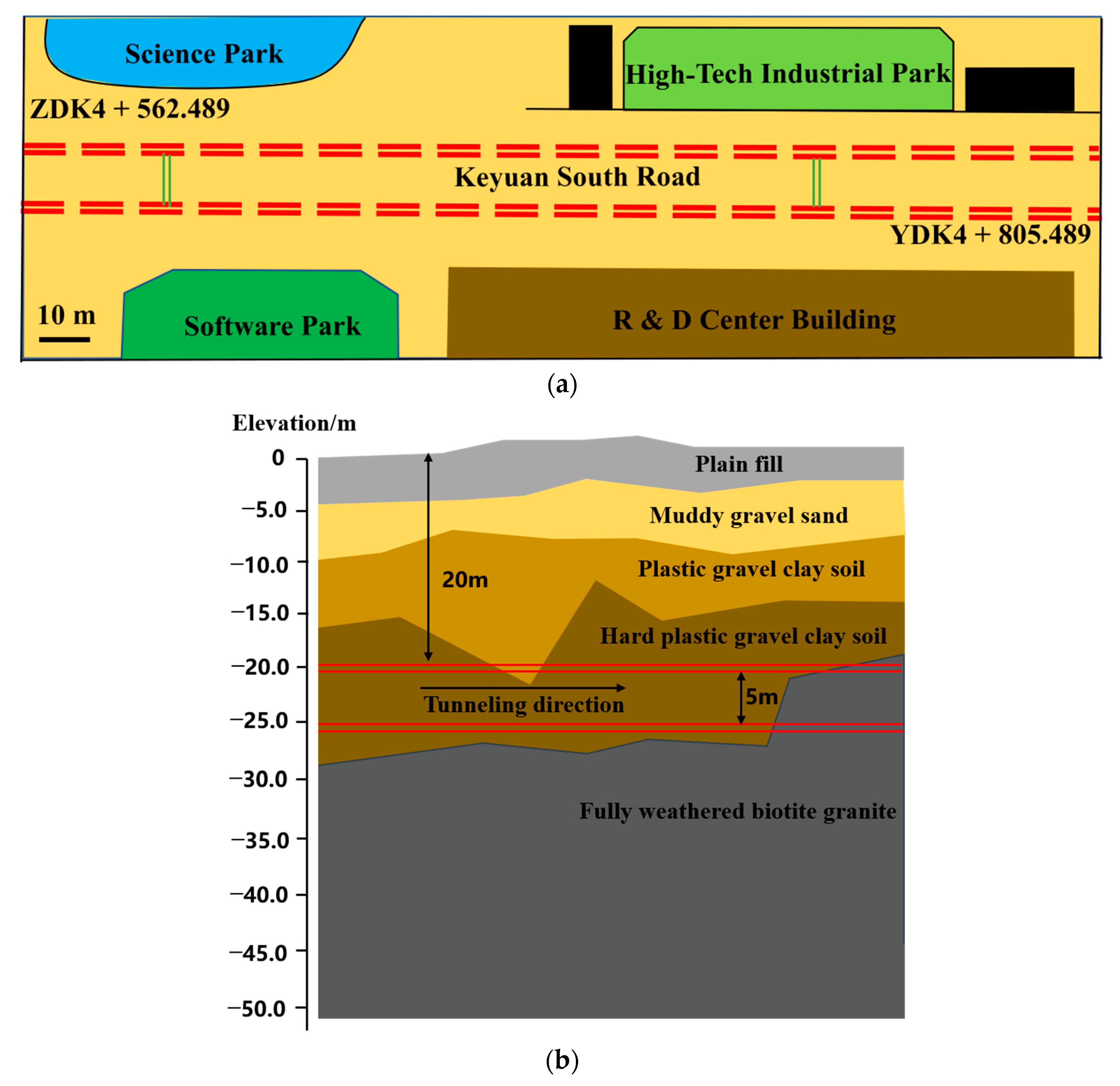
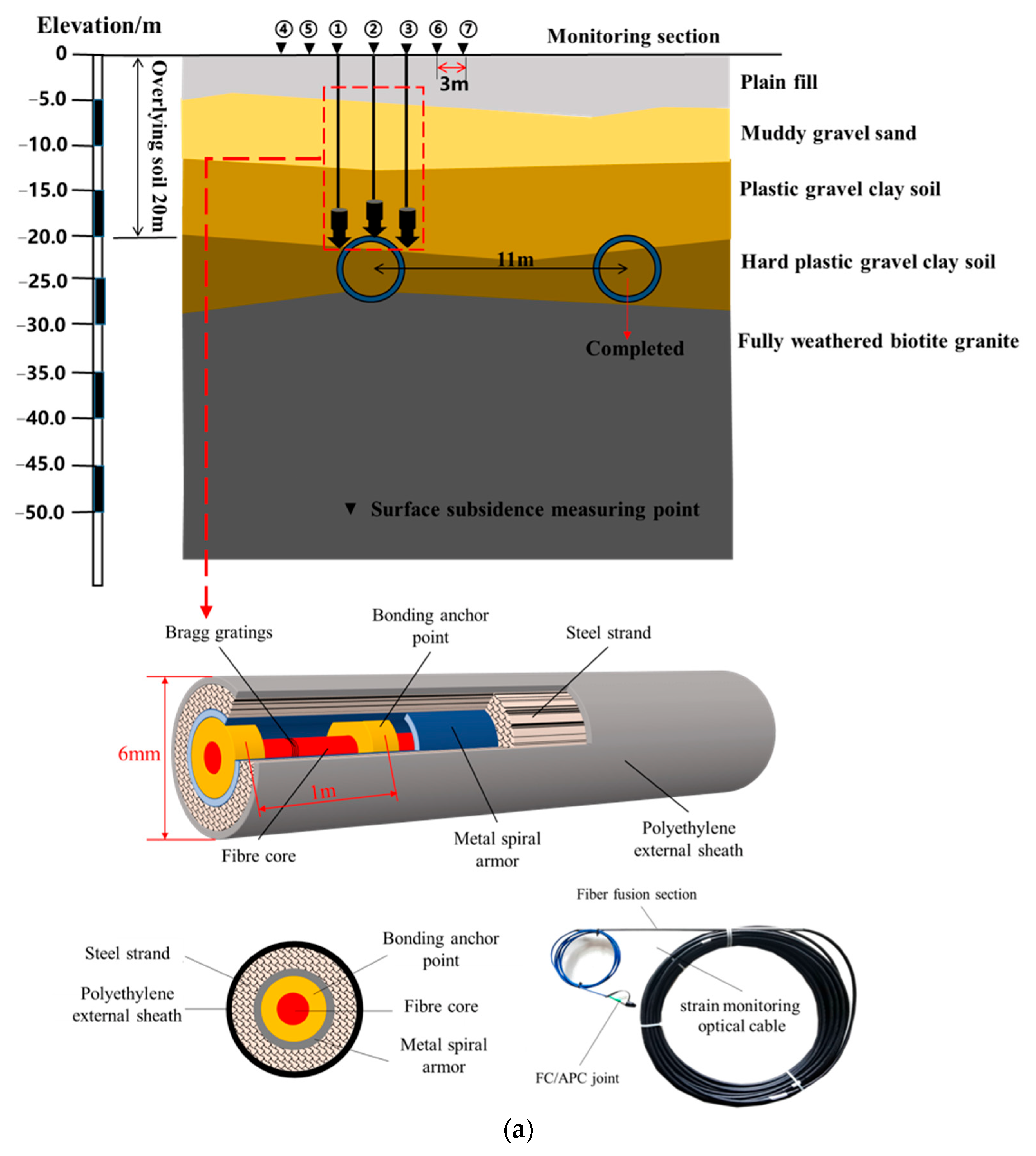
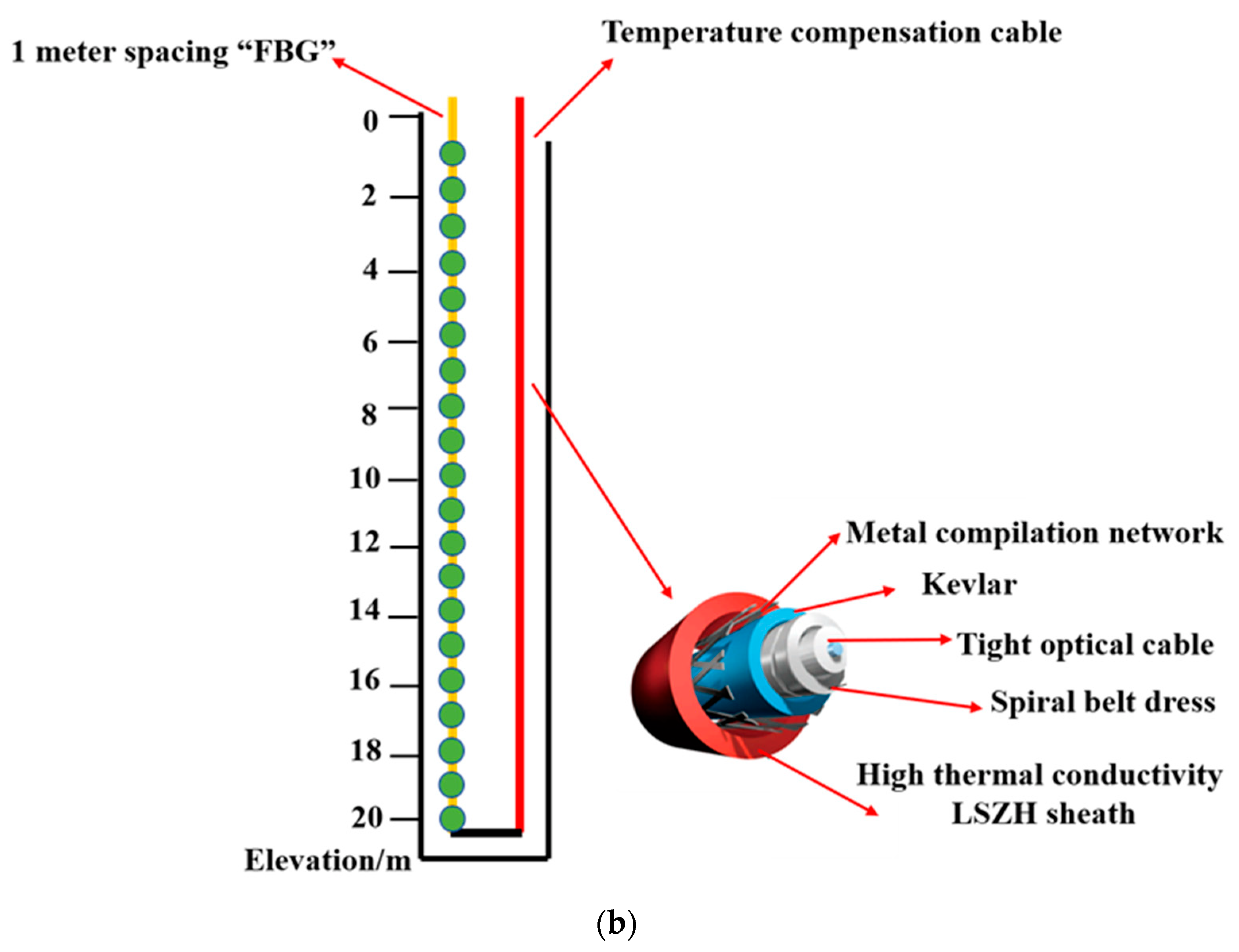
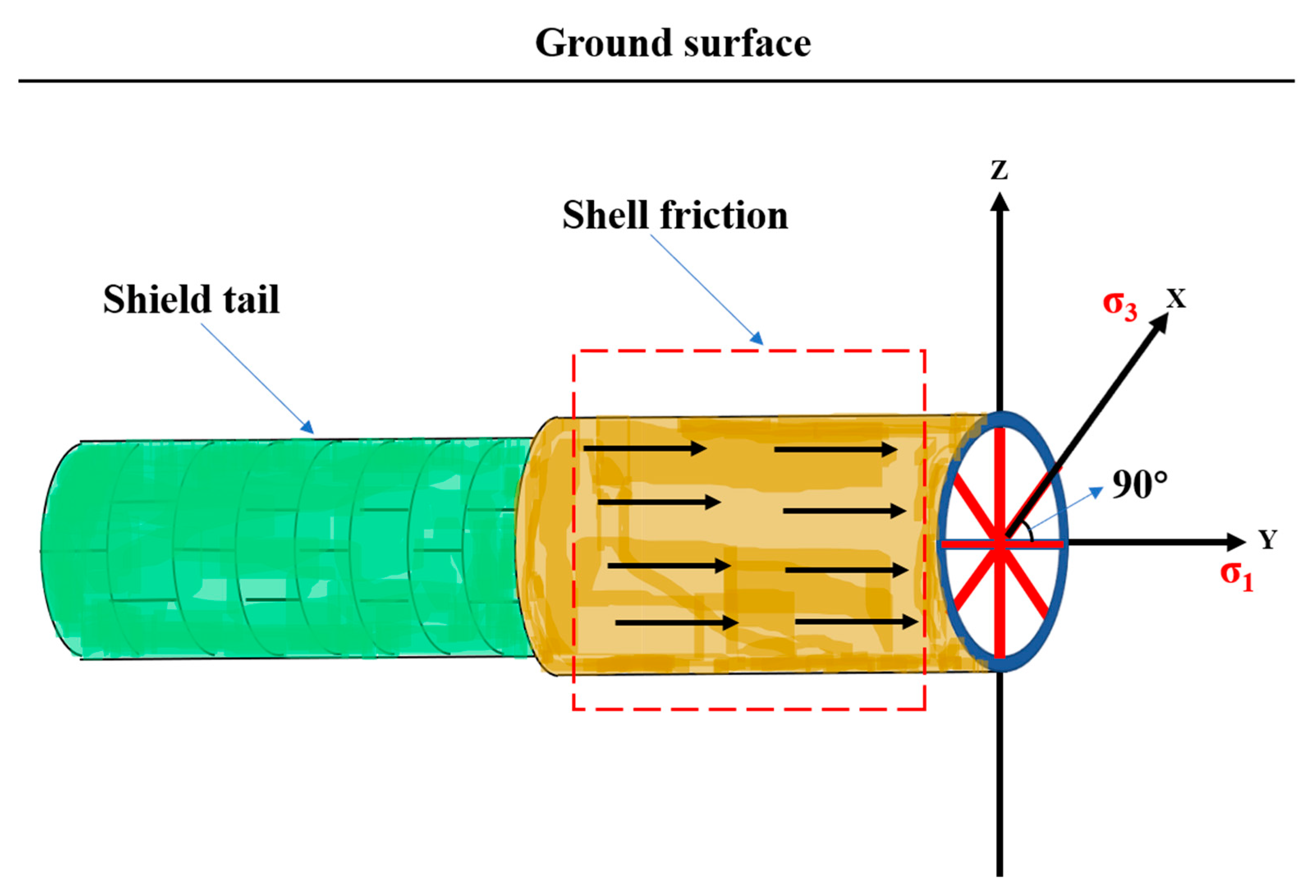
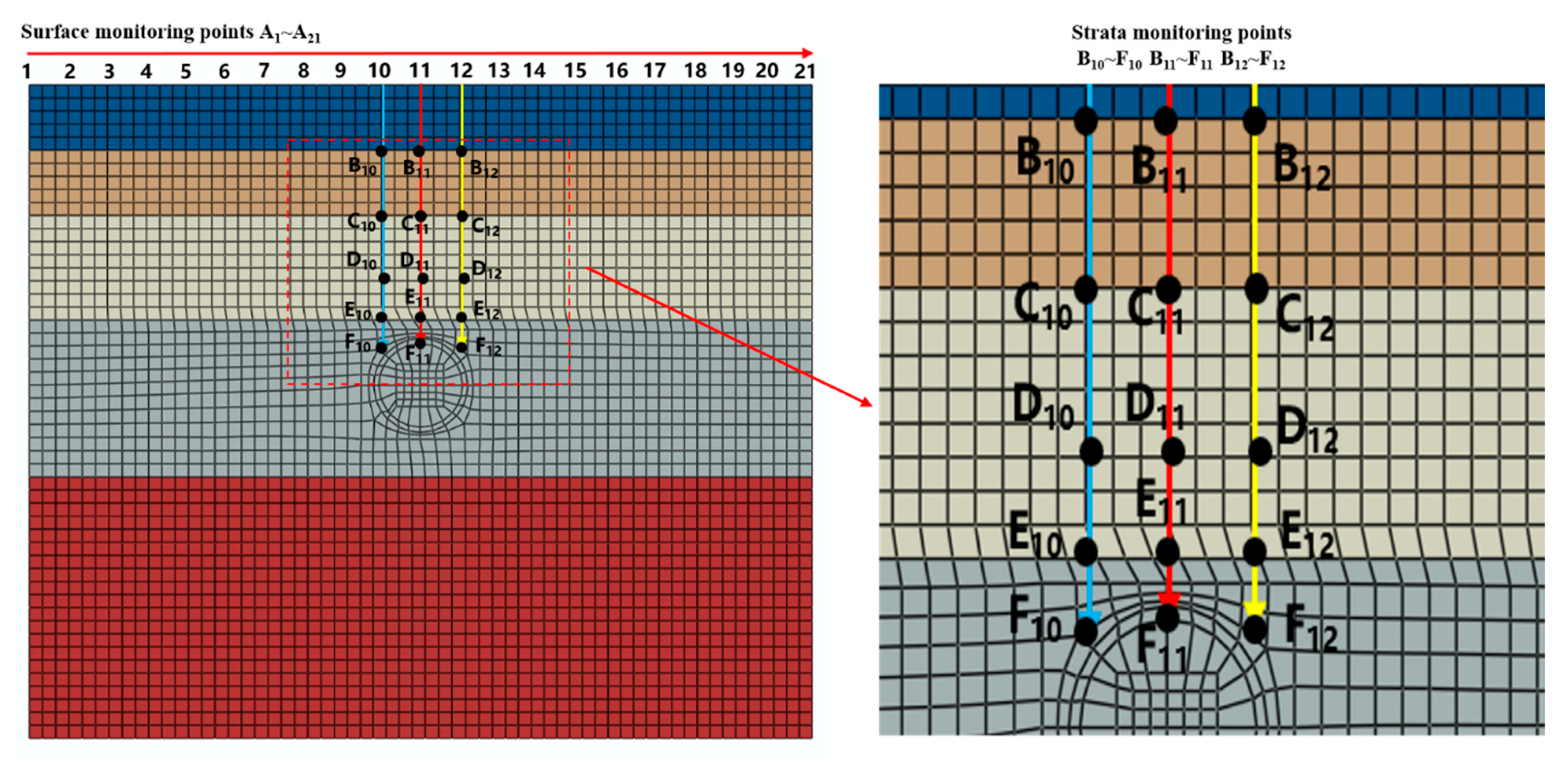
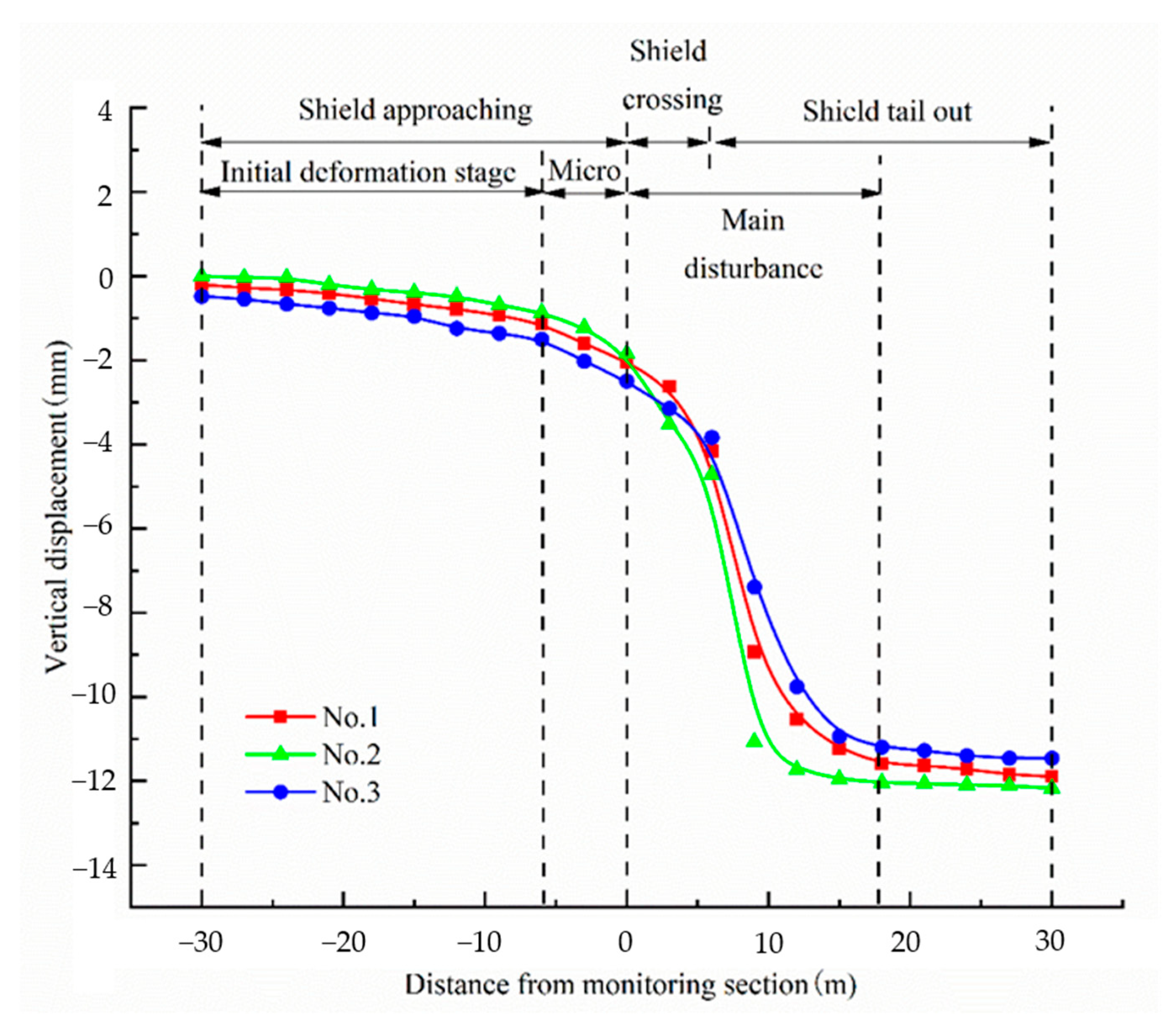
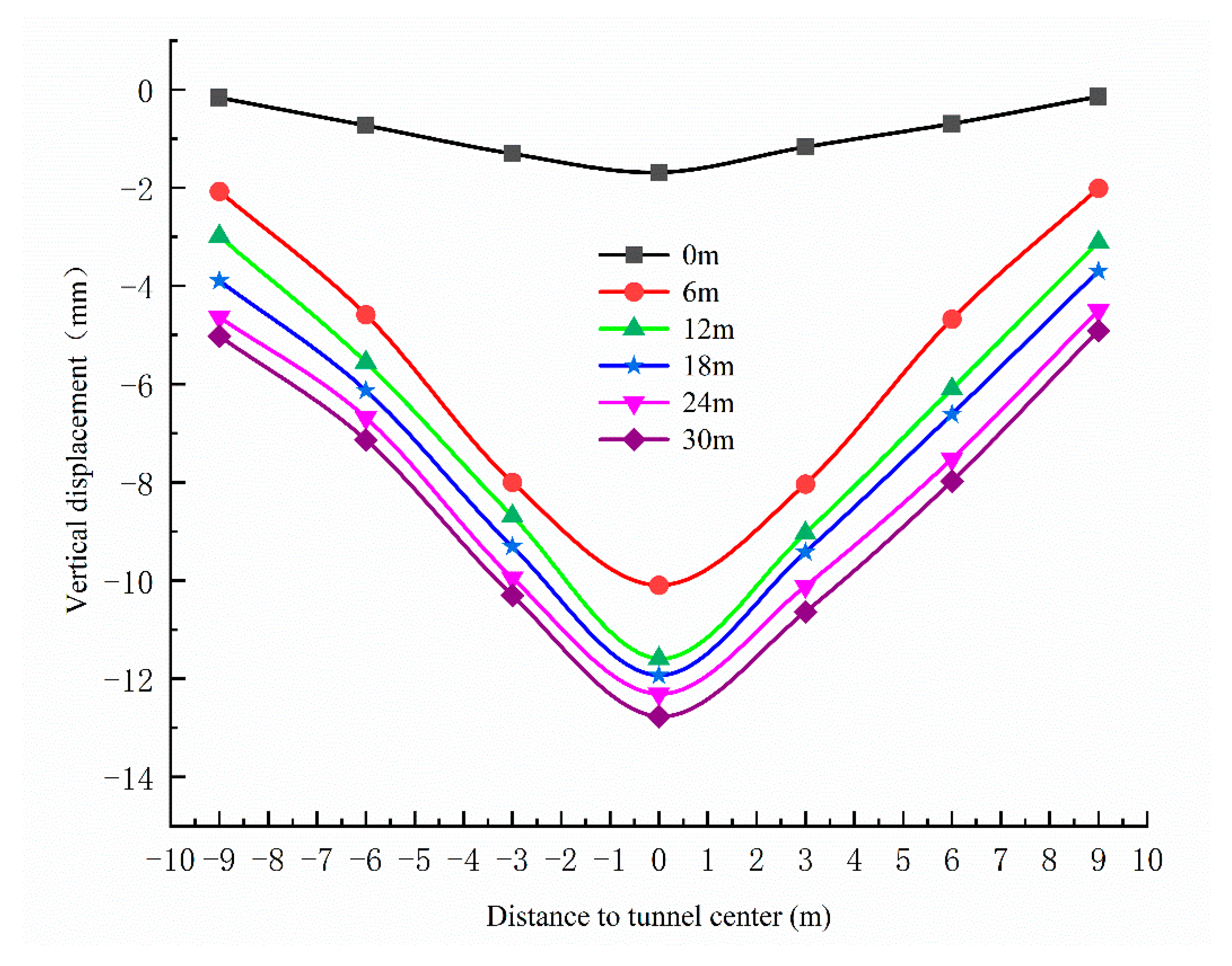

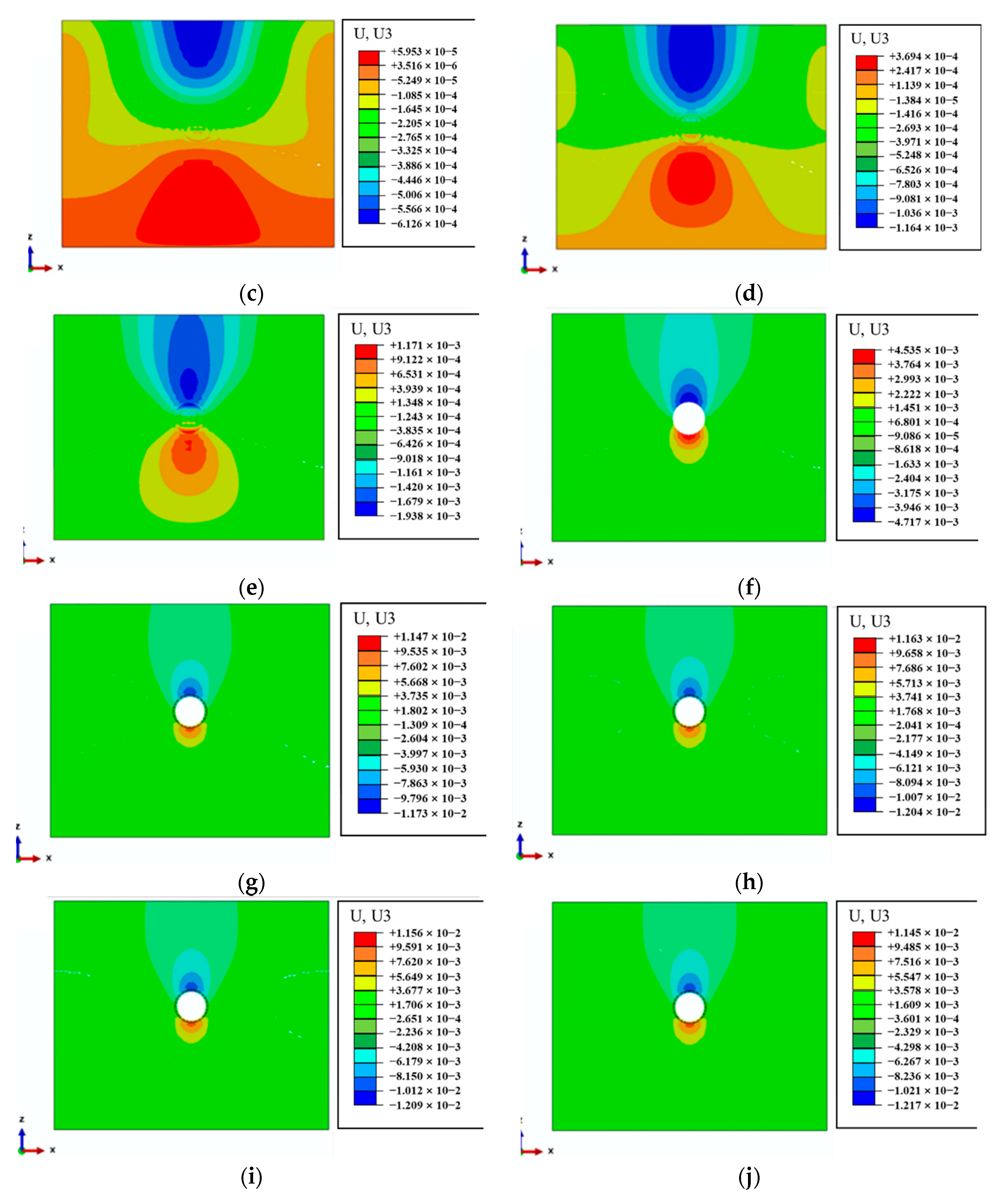
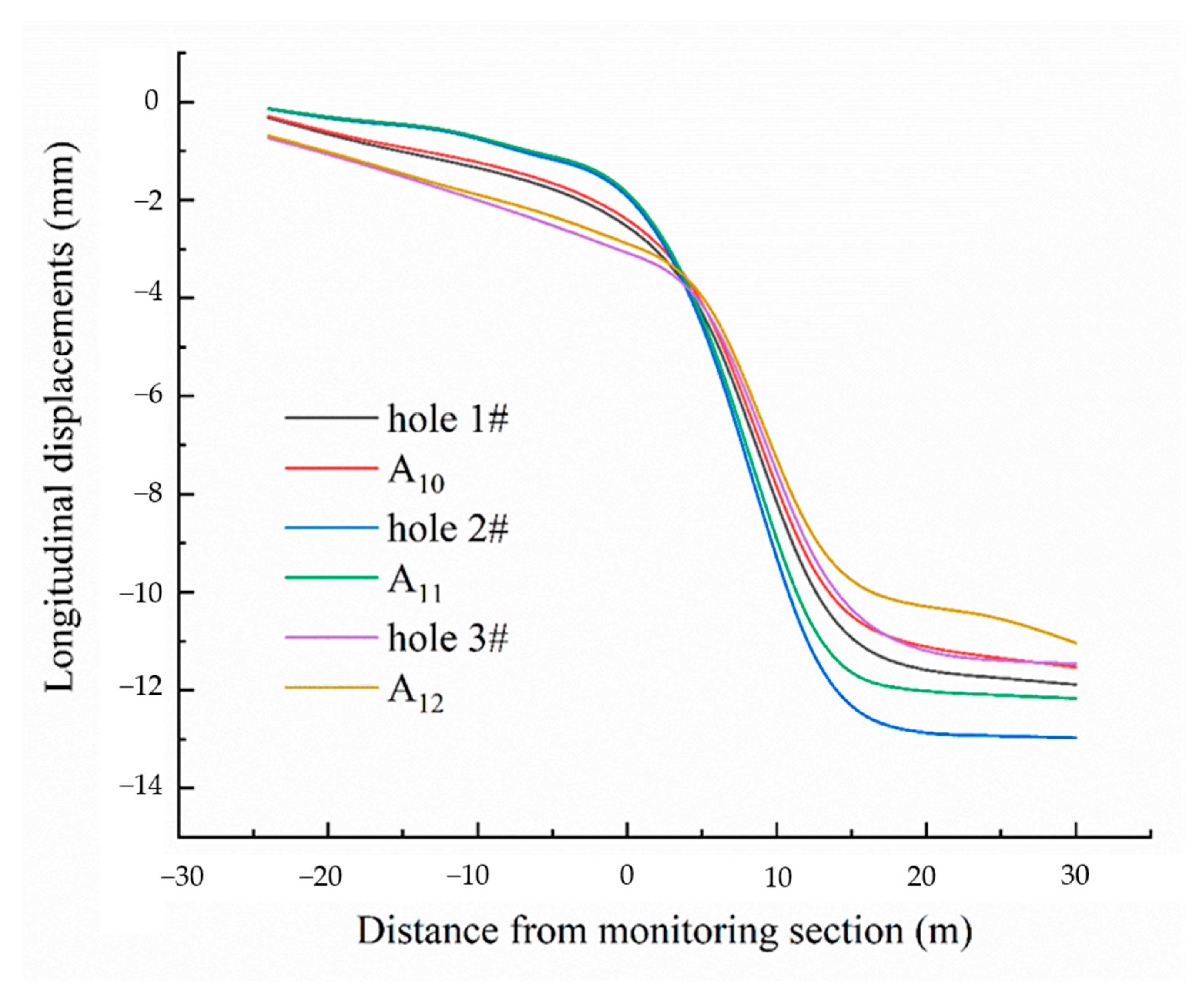

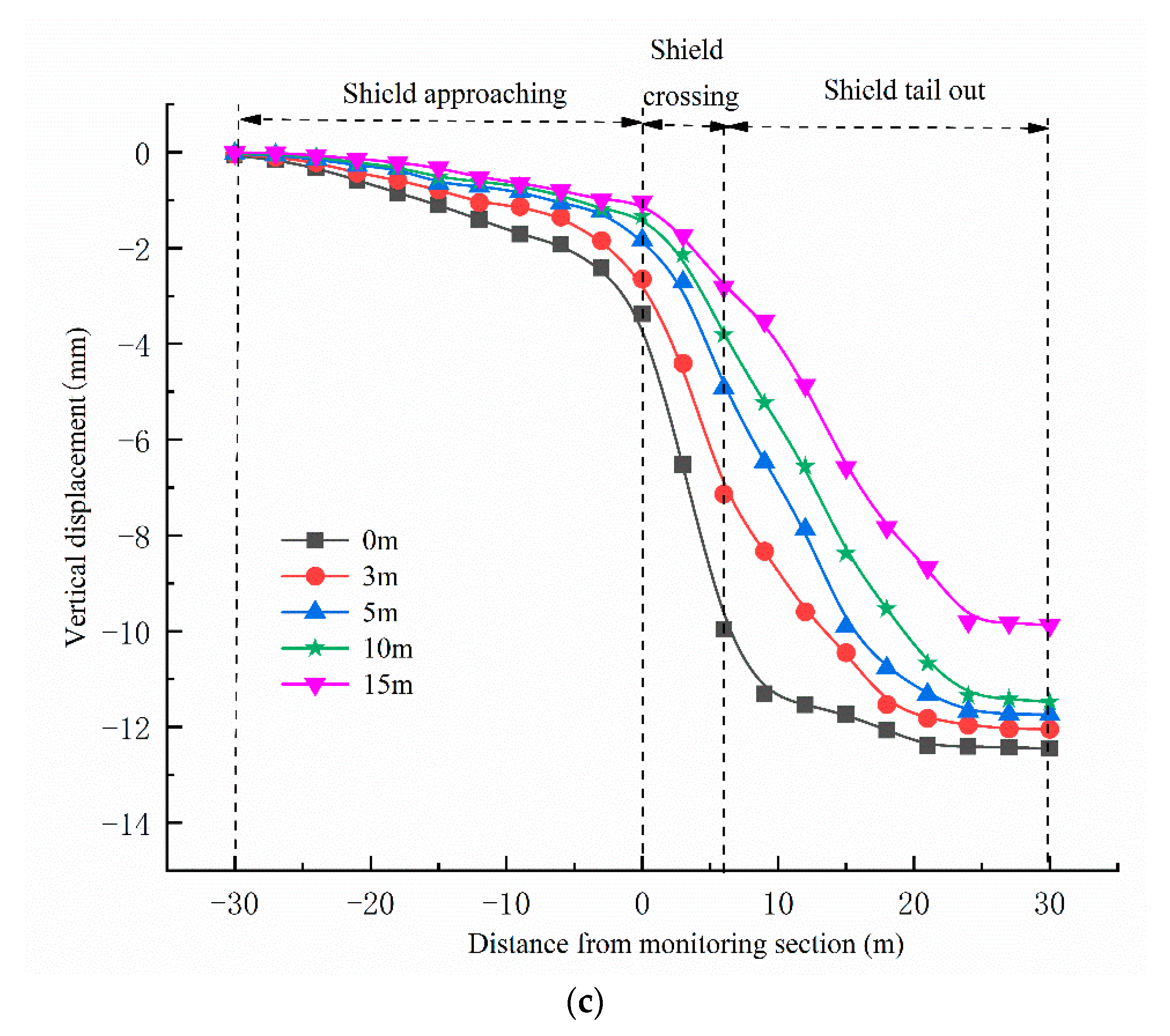
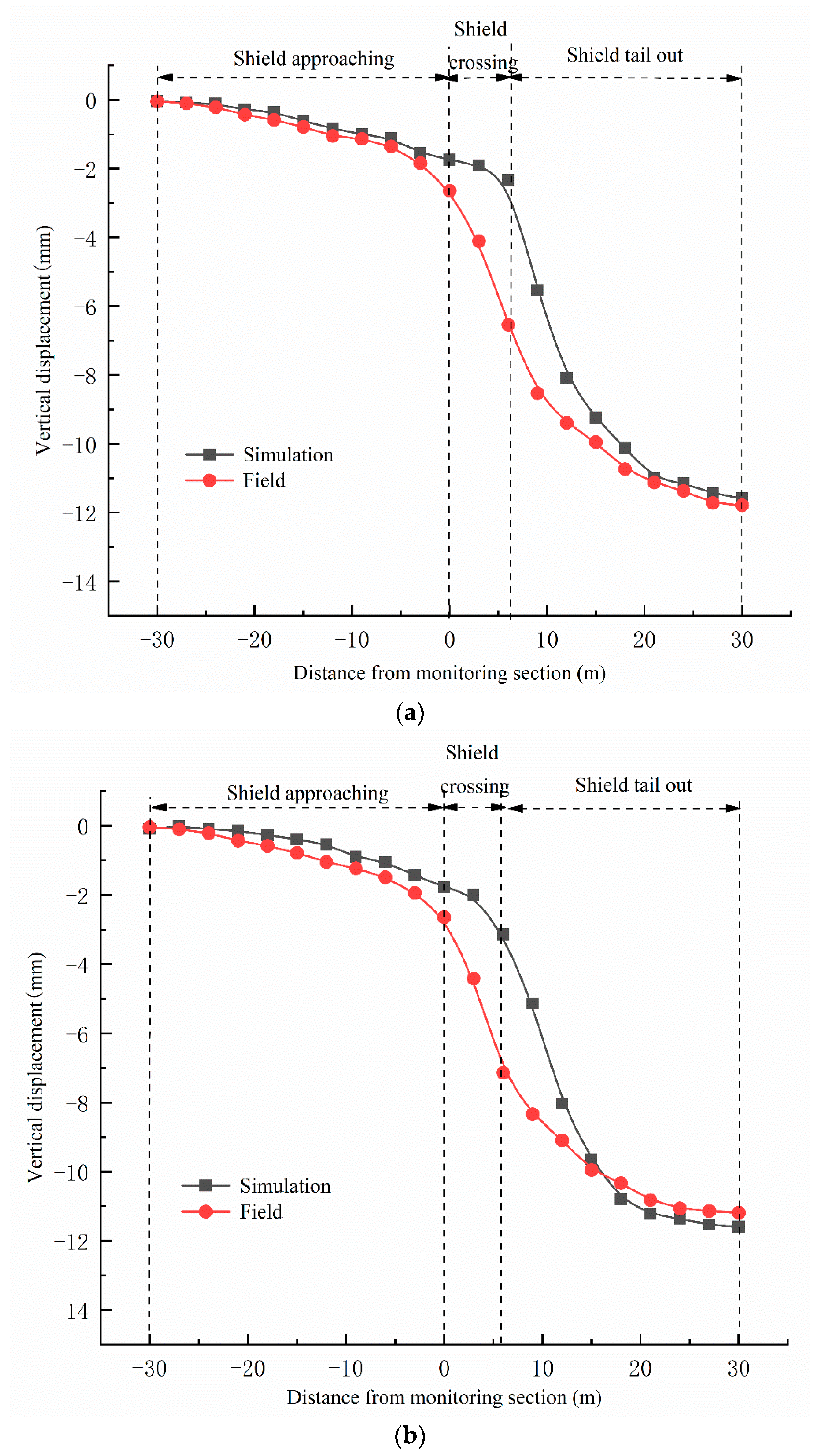
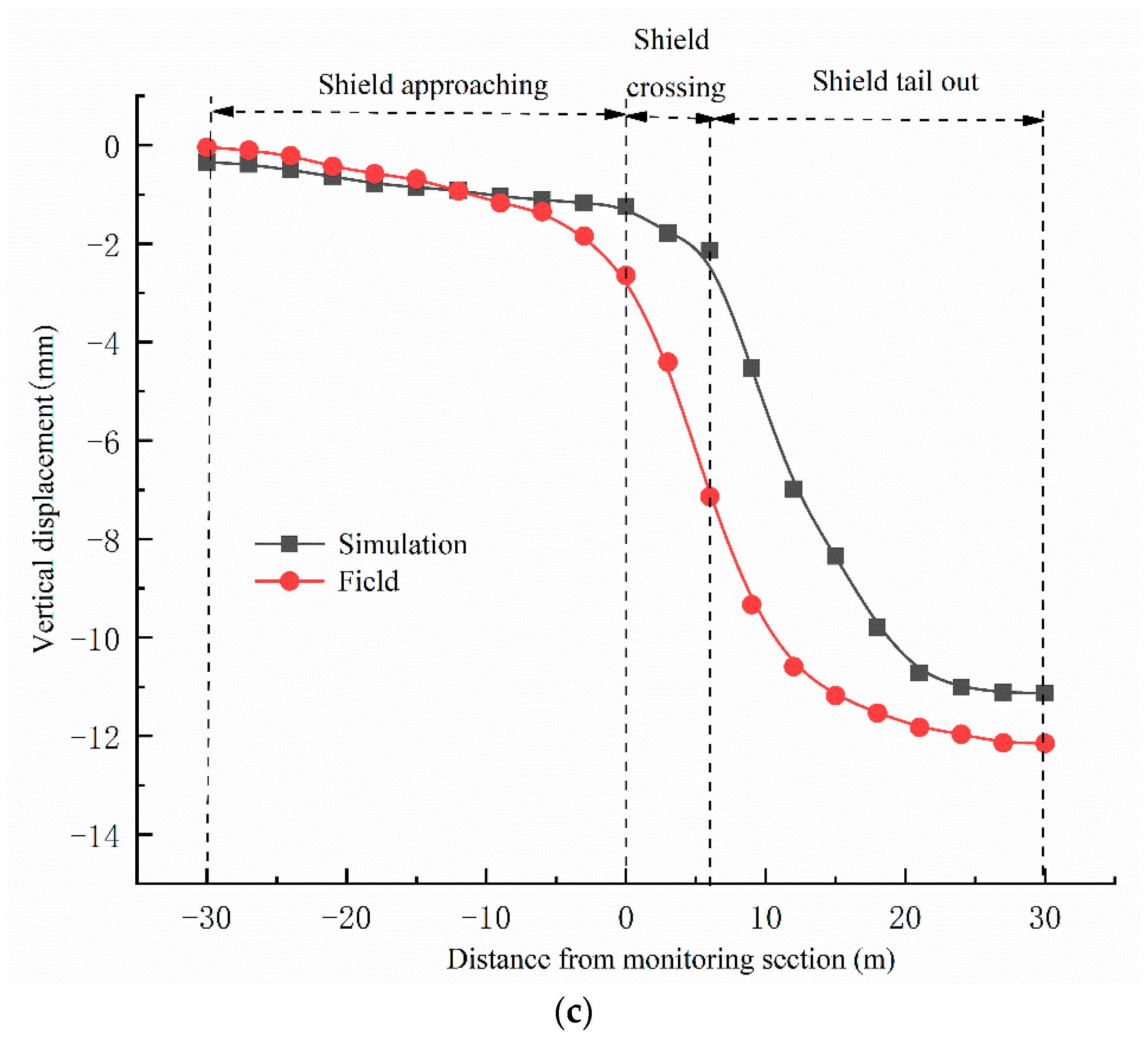

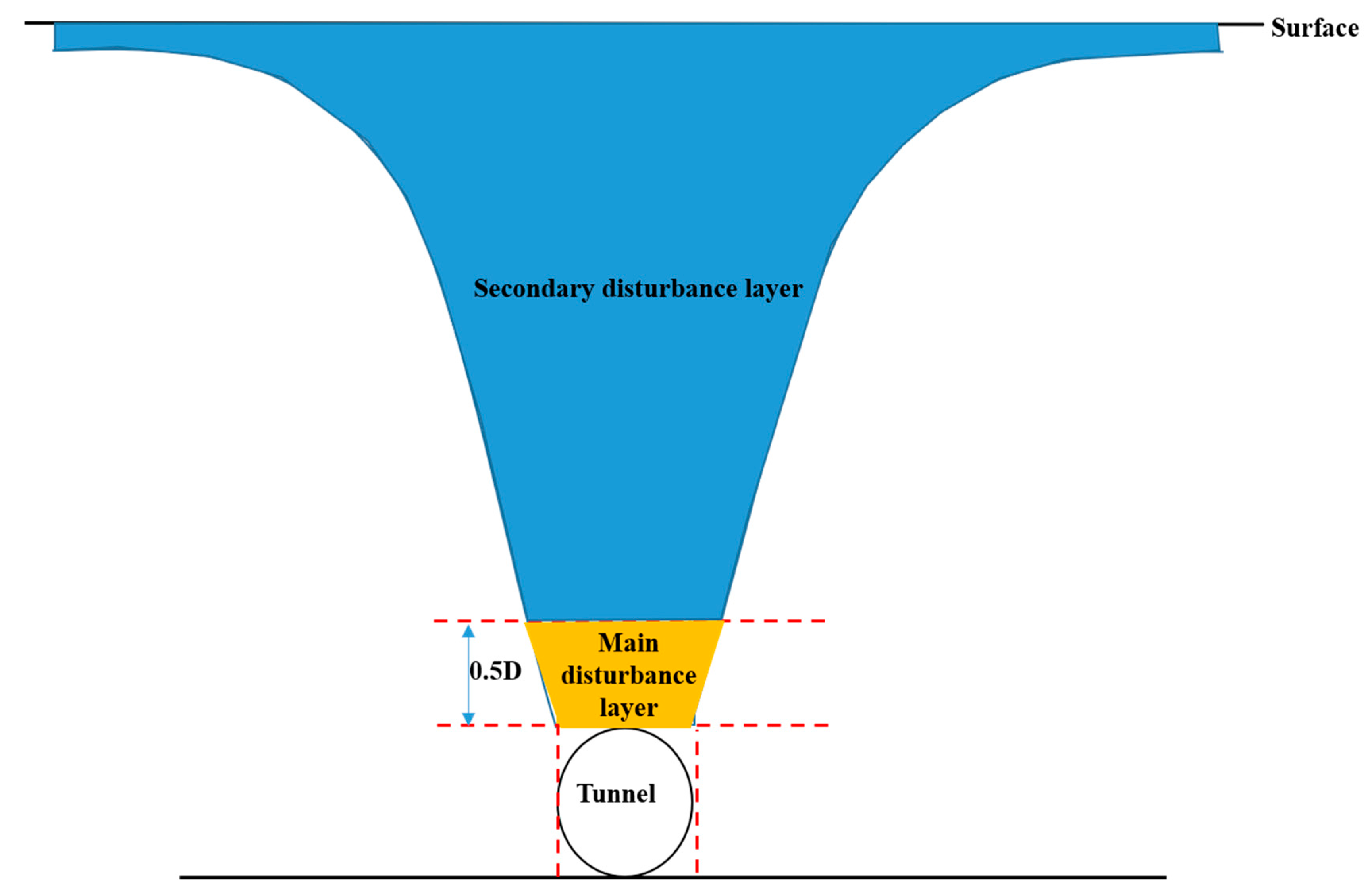
| Strata Name | Density (kN/m3) | Deformation Modulus (MPa) | Poisson’s Ratio | Cohesion (kPa) | Friction Angle (°) | Strata Thickness (m) |
|---|---|---|---|---|---|---|
| Plain fill | 21.0 | 16 | 0.30 | 6 | 12 | 5 |
| Muddy gravel sand | 19.5 | 18 | 0.31 | 12 | 10 | 5 |
| Plastic gravel clay soil | 18.3 | 15 | 0.34 | 20 | 28 | 7 |
| Hard plastic gravel clay soil | 19.0 | 30 | 0.32 | 23 | 26 | 13 |
| Fully weathered biotite granite | 19.5 | 70 | 0.29 | 30 | 22 | 20 |
| Distance (m) | −24 | −18 | −12 | −6 | 0 | 6 | 12 | 18 | 24 | 30 |
| Field monitoring (mm) | −0.32 | −0.84 | −1.20 | −1.62 | −2.37 | −4.15 | −10.53 | −11.59 | −11.72 | −11.89 |
| Numerical simulation (mm) | −0.29 | −0.78 | −1.08 | −1.51 | −2.23 | −3.97 | −10.14 | −11.07 | −11.31 | −11.53 |
| Absolute error (mm) | 0.03 | 0.06 | 0.12 | 0.11 | 0.14 | 0.18 | 0.39 | 0.52 | 0.41 | 0.36 |
| Relative error | 10.34% | 7.69% | 11.11% | 7.28% | 6.28% | 4.53% | 3.85% | 4.70% | 3.63% | 3.12% |
| Distance (m) | −24 | −18 | −12 | −6 | 0 | 6 | 12 | 18 | 24 | 30 |
| Field monitoring (mm) | −0.14 | −0.44 | −0.51 | −1.16 | −1.43 | −4.71 | −12.04 | −12.91 | −12.92 | −12.97 |
| Numerical simulation (mm) | −0.13 | −0.40 | −0.50 | −1.09 | −1.37 | −4.56 | −11.55 | −12.01 | −12.09 | −12.17 |
| Absolute error (mm) | 0.01 | 0.04 | 0.01 | 0.07 | 0.06 | 0.15 | 0.49 | 0.90 | 0.83 | 0.80 |
| Relative error | 7.7% | 1.0% | 2.0% | 6.4% | 4.4% | 3.3% | 4.2% | 7.8% | 6.9% | 6.6% |
| Distance (m) | −24 | −18 | −12 | −6 | 0 | 6 | 12 | 18 | 24 | 30 |
| Field monitoring (mm) | −0.74 | −1.23 | −1.81 | −2.39 | −3.09 | −3.73 | −9.75 | −11.19 | −11.40 | −11.46 |
| Numerical simulation (mm) | −0.69 | −1.18 | −1.75 | −2.19 | −2.89 | −3.58 | −9.46 | −10.29 | −10.39 | −11.04 |
| Absolute error (mm) | 0.05 | 0.05 | 0.06 | 0.20 | 0.20 | 0.15 | 0.29 | 0.90 | 1.01 | 0.42 |
| Relative error | 7.2% | 4.2% | 3.4% | 9.1% | 6.9% | 4.2% | 3.1% | 8.7% | 9.7% | 3.8% |
| Transverse Distance (m) | −30~0 | 0~6 | 6~30 | Total |
|---|---|---|---|---|
| Field monitoring (mm) Ratio | −2.65 22.5% −1.14 9.9% | −3.29 27.9% | −5.84 49.6% | −11.78 / |
| Numerical simulation (mm) Ratio | −1.20 10.4% | −9.20 79.7% | −11.54 / |
| Transverse Distance (m) | −30~0 | 0~6 | 6~30 | Total |
|---|---|---|---|---|
| Field monitoring (mm) Ratio | −2.73 22.8% −1.28 11.0% | −3.41 28.4% | −5.85 48.8% | −11.99 / |
| Numerical simulation (mm) Ratio | −1.86 16.0% | −8.46 73.0% | −11.60 / |
| Transverse Distance (m) | −30~0 | 0~6 | 6~30 | Total |
|---|---|---|---|---|
| Field monitoring (mm) Ratio | −2.50 20.6% −1.24 11.1% | −4.62 38.0% | −5.03 44.4% | −12.15 / |
| Numerical simulation (mm) Ratio | −1.68 15.1% | −8.21 73.8% | −11.13 / |
Disclaimer/Publisher’s Note: The statements, opinions and data contained in all publications are solely those of the individual author(s) and contributor(s) and not of MDPI and/or the editor(s). MDPI and/or the editor(s) disclaim responsibility for any injury to people or property resulting from any ideas, methods, instructions or products referred to in the content. |
© 2023 by the authors. Licensee MDPI, Basel, Switzerland. This article is an open access article distributed under the terms and conditions of the Creative Commons Attribution (CC BY) license (https://creativecommons.org/licenses/by/4.0/).
Share and Cite
Zhao, F.; Lu, X.; Shi, H.; Liu, B.; Liu, S.; Dai, K.; Fan, Y. Study on Stratified Settlement and Weak Reflectivity Fiber Grating Monitoring of Shield Tunnel Crossing Composite Strata. Appl. Sci. 2023, 13, 1769. https://doi.org/10.3390/app13031769
Zhao F, Lu X, Shi H, Liu B, Liu S, Dai K, Fan Y. Study on Stratified Settlement and Weak Reflectivity Fiber Grating Monitoring of Shield Tunnel Crossing Composite Strata. Applied Sciences. 2023; 13(3):1769. https://doi.org/10.3390/app13031769
Chicago/Turabian StyleZhao, Fucai, Xingli Lu, Hongbing Shi, Bin Liu, Shaoran Liu, Kaohong Dai, and Ying Fan. 2023. "Study on Stratified Settlement and Weak Reflectivity Fiber Grating Monitoring of Shield Tunnel Crossing Composite Strata" Applied Sciences 13, no. 3: 1769. https://doi.org/10.3390/app13031769
APA StyleZhao, F., Lu, X., Shi, H., Liu, B., Liu, S., Dai, K., & Fan, Y. (2023). Study on Stratified Settlement and Weak Reflectivity Fiber Grating Monitoring of Shield Tunnel Crossing Composite Strata. Applied Sciences, 13(3), 1769. https://doi.org/10.3390/app13031769





